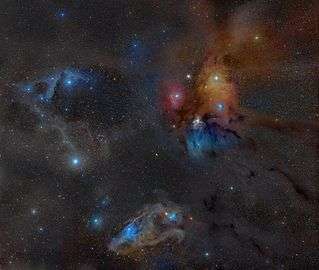Rho Ophiuchi cloud complex
| Dark nebula | |
|---|---|
|
The Rho Ophiuchi cloud complex. | |
| Observation data: J2000.0 epoch | |
| Right ascension | 16h 28m 06s[1] |
| Declination | –24° 32.5′[1] |
| Distance | 460 ly (140 pc)[2] ly |
| Apparent dimensions (V) | 4.5° × 6.5°[3] |
| Constellation | Ophiuchus |
| Designations | Ophiuchus molecular cloud, Integral 691, XSS J16271-2423 |
The Rho Ophiuchi cloud complex is a dark nebula of gas and dust that is located 1° south of the star ρ Ophiuchi of the constellation Ophiuchus. At an estimated distance of 131 ± 3 parsecs,[2][4] this cloud is one of the closest star-forming regions to the Solar System.[5]
Cloud complex
This cloud covers an angular area of 4.5° × 6.5° on the celestial sphere. It consists of two major regions of dense gas and dust. The first contains a star-forming cloud (L1688) and two filaments (L1709 and L1755), while the second has a star-forming region (L1689) and a filament (L1712–L1729). These filaments extend up to 10–17.5 parsecs in length and can be as narrow as 0.24 parsecs in width. Some of the structures within the complex appear to be the result of a shock front passing through the clouds from the direction of the neighboring Sco OB2 association.[3]
Temperatures of the clouds range from 13–22 K, and there is a total of about 3,000 times the mass of the Sun in material. Over half of the mass of the complex is concentrated around the L1688 cloud, and this is the most active star-forming region.[3] There are embedded infrared sources within the complex.[6] A total of 425 infrared sources have been detected near the L1688 cloud. These are presumed to be young stellar objects, including 16 classified as protostars, 123 T Tauri stars with dense circumstellar disks, and 77 weaker T Tauri stars with thinner disks.[2] The last two categories of stars have estimated ages ranging from 100,000 to a million years.[7]
The first brown dwarf to be identified in a star-forming region was Rho Oph J162349.8-242601, located in the Rho Ophiuchi cloud.[8] One of the older objects at the edge of the primary star-forming region was found to be a circumstellar disk seen nearly edge on. It spans a diameter of 300 AU and contains at least twice the mass of Jupiter. The million-year-old star at the center of the disk has a temperature of 3,000 K and is emitting 0.4 times the luminosity of the Sun.[9]
Gallery
 Young star 2MASS J16281370-2431391, surrounded by a disc of gas and dust.[10]
Young star 2MASS J16281370-2431391, surrounded by a disc of gas and dust.[10] False-color view of the complex.
False-color view of the complex. Visible light wide field view of the colourful nebulosity surrounding the complex.
Visible light wide field view of the colourful nebulosity surrounding the complex. Photo of the binary star system Rho Ophiuchi.
Photo of the binary star system Rho Ophiuchi.
See also
References
- 1 2 "RHO OPH REGION -- Molecular Cloud". SIMBAD. Centre de Données astronomiques de Strasbourg. Retrieved 2009-10-24.
- 1 2 3 Bontemps, S.; et al. (June 2001). "ISOCAM observations of the rho Ophiuchi cloud: Luminosity and mass functions of the pre-main sequence embedded cluster". Astronomy and Astrophysics. 372: 173–194. arXiv:astro-ph/0103373
 . Bibcode:2001A&A...372..173B. doi:10.1051/0004-6361:20010474.
. Bibcode:2001A&A...372..173B. doi:10.1051/0004-6361:20010474. - 1 2 3 Loren, Robert B. (March 15, 1989). "The cobwebs of Ophiuchus. I - Strands of (C-13)O - The mass distribution". Astrophysical Journal, Part 1. 338: 902–924. Bibcode:1989ApJ...338..902L. doi:10.1086/167244.
- ↑ Mamajek, E.E. (2008). "On the distance to the Ophiuchus star-forming region". Astronomische Nachrichten. 329: 10–14. arXiv:0709.0505
 . Bibcode:2008AN....329...10M. doi:10.1002/asna.200710827.
. Bibcode:2008AN....329...10M. doi:10.1002/asna.200710827. - ↑ "Young Stars in Their Baby Blanket of Dust". Spitzer Multimedia Features. NASA. 2008-11-02. Retrieved 2009-10-24.
- ↑ Wilking, B. A.; Lada, C. J. (November 15, 1983). "The discovery of new embedded sources in the centrally condensed core of the Rho Ophiuchi dark cloud - The formation of a bound cluster". Astrophysical Journal, Part 1. 274: 698–716. Bibcode:1983ApJ...274..698W. doi:10.1086/161482.
- ↑ Luhman, K. L.; Rieke, G. H. (November 1999). "Low-Mass Star Formation and the Initial Mass Function in the ρ Ophiuchi Cloud Core". The Astrophysical Journal. 525 (1): 440–465. arXiv:astro-ph/9905286
 . Bibcode:1999ApJ...525..440L. doi:10.1086/307891.
. Bibcode:1999ApJ...525..440L. doi:10.1086/307891. - ↑ Martín, E. L. (2001). Hugh R. A. Jones; Iain A. Steele, eds. Spectroscopy of Young Brown Dwarfs and Isolated Planetary Mass Objects. Springer. pp. 153–167. ISBN 3-540-42353-2.
- ↑ Grosso, Nicolas (May 7, 2002). "Infrared Images of an Infant Solar System". Press Releases. European Southern Observatory. Retrieved 2009-10-25.
- ↑ "The Deep-Frozen Flying Saucer". Retrieved 8 February 2016.
External links
- Astronomy Picture of the Day
- The Colorful Clouds of Rho Ophiuchi 2007 September 3
- Young Stars in the Rho Ophiuchi Cloud 2009 November 13
- Rho Ophiucus Wide Field 2010 May 24
